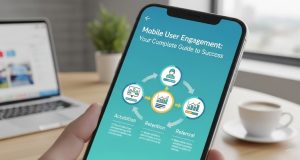Why Mobile Marketing is No Longer Optional for Businesses

Your customers are scrolling, tapping, and swiping their way through life. Right now, someone is checking their phone while walking to work, browsing products during their lunch break, or making a purchase while watching Netflix. If your business isn’t meeting them there, you’re missing out on the biggest marketing opportunity of our time.
Mobile marketing has evolved from a nice-to-have strategy to an absolute necessity. With over 6.8 billion smartphone users worldwide and mobile devices accounting for more than half of all web traffic, the question isn’t whether you should invest in mobile marketing—it’s how quickly you can adapt your strategy to capture this massive audience.
This shift represents more than just changing technology; it’s a fundamental transformation in how people discover, research, and buy products. Mobile marketing encompasses everything from responsive website design and SMS campaigns to mobile apps and location-based advertising. For businesses that master this channel, the rewards are substantial: higher engagement rates, increased sales, and stronger customer relationships.
The Mobile Marketing Revolution is Here

Mobile devices have fundamentally changed consumer behavior. People now expect instant access to information, seamless shopping experiences, and personalized content delivered directly to their pocket. This shift has created unprecedented opportunities for businesses willing to adapt their marketing strategies.
Mobile Usage Statistics Paint a Clear Picture
The numbers tell a compelling story about mobile dominance. Mobile devices generate approximately 60% of all website traffic, and this percentage continues to grow year over year. More importantly, mobile commerce now accounts for nearly 73% of total e-commerce sales, representing a trillion-dollar market opportunity.
Social media consumption has also shifted predominantly to mobile platforms. Over 95% of Facebook users access the platform via mobile devices, while Instagram and TikTok are almost exclusively mobile experiences. This means your social media marketing strategy must be mobile-first to achieve maximum impact.
Consumer Expectations Have Evolved
Modern consumers expect mobile experiences that load quickly, navigate smoothly, and provide value immediately. Research shows that 53% of mobile users abandon websites that take longer than three seconds to load. This creates a significant challenge for businesses that haven’t optimized their mobile presence.
Beyond speed, consumers expect personalization based on their location, browsing history, and preferences. Mobile marketing allows for this level of customization through GPS targeting, push notifications, and behavior-based messaging that desktop marketing simply cannot match.
Core Components of Effective Mobile Marketing
Successful mobile marketing requires a comprehensive approach that touches every aspect of the customer journey. Each component works together to create a cohesive experience that drives engagement and conversions.
Mobile-Optimized Websites and Apps
Your website serves as the foundation of your mobile marketing strategy. Mobile-responsive design ensures your content displays properly across all screen sizes, but true mobile optimization goes deeper. It involves reimagining user interfaces, simplifying navigation, and prioritizing the most important information for mobile users.
Progressive Web Apps (PWAs) represent an emerging trend that combines the best features of websites and mobile apps. PWAs load instantly, work offline, and can send push notifications, providing an app-like experience without requiring users to download anything from an app store.
Native mobile apps offer the highest level of engagement and functionality but require significant investment in development and maintenance. Apps work best for businesses with strong customer loyalty programs, frequent-use services, or complex functionality that benefits from native mobile features.
SMS and Push Notification Marketing
Text messaging remains one of the most effective mobile marketing channels, with open rates exceeding 95% and response rates significantly higher than email marketing. SMS marketing works particularly well for time-sensitive promotions, appointment reminders, and order updates.
Push notifications allow businesses with mobile apps to reach users instantly, even when the app isn’t actively being used. Effective push notification strategies balance promotional messages with valuable information like shipping updates, personalized recommendations, and relevant news.
The key to successful SMS and push notification marketing lies in timing, frequency, and personalization. Messages should provide genuine value and respect user preferences to avoid being perceived as spam.
Social Media Mobile Marketing
Social media platforms prioritize mobile experiences, making them natural channels for mobile marketing. Instagram Stories, TikTok videos, and Facebook mobile ads are designed specifically for mobile consumption and tend to achieve higher engagement rates than their desktop counterparts.
Vertical video content has become essential as users hold their phones upright most of the time. Businesses that create content specifically for mobile viewing, rather than repurposing desktop content, see significantly better performance across all social platforms.
Live streaming represents another powerful mobile marketing opportunity. Platforms like Instagram Live, Facebook Live, and TikTok Live allow businesses to connect with audiences in real-time, showcase products, and build authentic relationships that drive long-term loyalty.
Location-Based Marketing
Mobile devices provide precise location data that enables highly targeted marketing campaigns. Geofencing allows businesses to trigger advertisements, push notifications, or special offers when customers enter specific geographic areas.
Local search optimization becomes crucial as mobile users frequently search for nearby businesses. “Near me” searches have grown exponentially, and businesses that appear prominently in local search results capture significantly more foot traffic and phone calls.
Beacon technology takes location-based marketing even further by enabling indoor positioning and micro-location targeting. Retail stores use beacons to send personalized offers to customers based on their exact location within the store.
Benefits That Drive Real Business Results
Mobile marketing delivers measurable benefits that directly impact your bottom line. Understanding these advantages helps justify investment and guide strategy development.
Higher Engagement Rates
Mobile marketing consistently outperforms traditional channels in terms of engagement. Mobile users interact with content more frequently, share it more often, and spend more time consuming multimedia content like videos and interactive elements.
Email campaigns optimized for mobile achieve open rates 20-30% higher than desktop-only campaigns. Mobile-first email design with larger buttons, simplified layouts, and shorter subject lines resonates better with users checking email on their phones.
Improved Customer Experience
Mobile marketing enables businesses to meet customers where they are and provide value in the moment. Whether someone needs directions to your store, wants to check product availability, or needs customer support, mobile channels can provide instant assistance.
Omnichannel experiences become possible when mobile marketing integrates with other touchpoints. Customers might research products on their phone, compare prices on their tablet, and complete purchases on their desktop, all while receiving consistent messaging and personalized recommendations.
Better Targeting and Personalization
Mobile devices generate rich data about user behavior, preferences, and context that enables sophisticated targeting. Marketers can deliver different messages based on time of day, location, device type, and past interactions.
Machine learning algorithms can analyze mobile user behavior patterns to predict future actions and optimize marketing campaigns in real-time. This level of personalization drives higher conversion rates and customer satisfaction.
Cost-Effective Reach
Mobile marketing often delivers better return on investment than traditional advertising channels. SMS marketing costs a fraction of direct mail campaigns while achieving higher response rates. Social media advertising on mobile platforms typically costs less per engagement than desktop advertising.
The ability to target specific audiences reduces wasted ad spend and improves campaign efficiency. Mobile advertising platforms provide detailed analytics that help optimize campaigns and allocate budgets more effectively.
Implementation Strategies for Success

Creating an effective mobile marketing strategy requires careful planning, proper execution, and continuous optimization. Success comes from understanding your audience and choosing the right mix of mobile marketing tactics.
Audit Your Current Mobile Presence
Start by evaluating how your business currently appears on mobile devices. Test your website on various smartphones and tablets to identify usability issues. Check your social media profiles for mobile optimization and review your competitors’ mobile strategies for insights and opportunities.
Google’s Mobile-Friendly Test tool provides specific recommendations for improving your website’s mobile performance. Page speed testing tools can identify technical issues that might be hurting your mobile search rankings or user experience.
Develop Mobile-First Content
Create content specifically designed for mobile consumption rather than adapting desktop content. This means shorter paragraphs, larger fonts, vertical images and videos, and simplified navigation structures.
Video content should be optimized for mobile viewing with clear audio, large text overlays, and engaging visuals that work well on small screens. Consider creating different versions of content for different mobile platforms to maximize performance.
Choose the Right Mobile Marketing Channels
Not every mobile marketing channel will be right for your business. B2B companies might focus more on LinkedIn mobile ads and email marketing, while retail businesses might prioritize Instagram shopping features and location-based advertising.
Consider your customer journey and identify the mobile touchpoints that will have the greatest impact on your business objectives. Start with one or two channels and expand gradually as you develop expertise and see results.
Measure and Optimize Performance
Mobile marketing success requires continuous measurement and optimization. Track key metrics like mobile website conversion rates, app engagement statistics, SMS response rates, and mobile advertising performance.
Use analytics tools to understand how mobile users interact with your content differently than desktop users. This insight helps refine your mobile marketing strategy and improve results over time.
Overcoming Common Mobile Marketing Challenges
Mobile marketing presents unique challenges that require specific solutions. Understanding these obstacles and preparing for them increases your chances of success.
Technical Limitations
Mobile devices have smaller screens, limited processing power, and varying internet connection speeds. These constraints require marketers to prioritize essential information and optimize for fast loading times.
Different operating systems (iOS vs. Android) and device manufacturers create fragmentation that complicates app development and testing. Successful mobile marketing strategies account for these technical variations and ensure consistent experiences across platforms.
Privacy and Permission Management
Mobile users are increasingly concerned about privacy and data usage. Successful mobile marketing requires transparent communication about data collection and respect for user preferences regarding notifications and location tracking.
Implementing clear opt-in processes and providing easy opt-out options builds trust and ensures compliance with privacy regulations like GDPR and CCPA. Businesses that prioritize user privacy often achieve better long-term engagement rates.
Content Adaptation
Creating content that works well on mobile devices requires different approaches than traditional marketing content. Text must be concise, images must be clearly visible on small screens, and calls-to-action must be easy to tap with a finger.
Video content presents particular challenges as mobile users often watch without sound. Successful mobile video marketing includes captions, visual storytelling techniques, and hooks that capture attention within the first few seconds.
The Future of Mobile Marketing
Mobile marketing continues to evolve rapidly with new technologies and changing user behaviors. Staying ahead of these trends helps businesses maintain competitive advantages and capitalize on emerging opportunities.
Emerging Technologies
5G networks are enabling new mobile experiences with faster speeds and lower latency. This technology makes possible enhanced augmented reality experiences, higher-quality video streaming, and more sophisticated mobile applications.
Artificial intelligence and machine learning are becoming more sophisticated at predicting user behavior and personalizing mobile experiences. Chatbots, recommendation engines, and automated customer service are improving while becoming more accessible to smaller businesses.
Changing User Expectations
Mobile users continue to expect faster, more personalized, and more convenient experiences. Voice search is growing rapidly, requiring businesses to optimize for conversational queries and featured snippets.
Privacy consciousness is increasing, with users demanding more control over their data and marketing preferences. Successful mobile marketing strategies will need to balance personalization with privacy protection.
Your Mobile Marketing Success Starts Now
Mobile marketing is not a trend that will fade away—it represents the fundamental shift in how business and consumers connect. Companies that embrace this reality and invest in comprehensive mobile marketing strategies will thrive, while those that resist will struggle to remain competitive.
The most successful approach involves starting with your customers’ needs and working backward to determine which mobile marketing tactics will deliver the most value. Focus on creating genuine value through mobile channels rather than simply pushing promotional messages to smaller screens.
Begin by auditing your current mobile presence, identifying the biggest opportunities for improvement, and implementing changes systematically. Mobile marketing success builds over time through consistent effort, continuous learning, and relentless focus on user experience.
The mobile revolution has already happened. The question is whether your business will lead, follow, or be left behind. The time to act is now.





